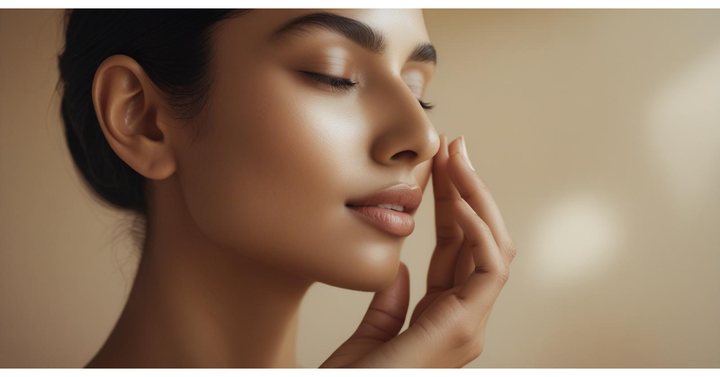
💎 Why You’ll Love It
- Makeup remover cream that removes waterproof makeup — Triple-action deep cleanse formula dissolves mascara, lipstick, foundation & sunscreen in seconds with no harsh rubbing.
- Protects sensitive skin — Gentle formula respects your skin’s acid mantle & pH balance, avoiding irritation or dryness.
- Flawless, camera-ready finish — Preps skin for makeup, smoothing texture & preventing cakiness on selfies or video.
- Eco-friendly makeup wipe alternative — A sustainable, zero-waste solution that nourishes skin while protecting the planet.
-
Hydrating makeup remover cream — Infused with Red Raspberry Oil & phytochemicals to leave skin supple, soft, and glowing.
This is a one of a kind Makeup remover cream that melts waterproof makeup, hydrates sensitive skin, and is the eco-conscious alternative to wipes.

🔬 The Science & Sensory Experience
A Ritual of Restoration
From the first scoop, Moviestar™ Makeup Melter Cream transforms cleansing into luxury. The natural fragrance of Rose & Lavender calms the senses. Its creamy texture melts on contact, dissolving the day’s makeup and pollutants. With each massage, stress seems to vanish, leaving skin calm, radiant, and deeply moisturized.
Powered by Star Ingredients
- Red Raspberry Oil — Rich in fatty acids and antioxidants, it hydrates, soothes inflammation, and helps protect from environmental stressors like UV & pollution.
- Manjishtha — A revered Ayurvedic purifier that helps unclog pores, brighten dark spots, and refine skin texture.
- Grapeseed Oil — A lightweight cleansing oil that removes impurities without clogging pores, ideal for sensitive and acne-prone skin.
Why It’s Superior to Wipes
- Wipes don’t truly cleanse. They smear makeup and pollutants into pores, leading to congestion. Our cream dissolves residue completely.
- Wipes damage skin. The physical tugging causes micro-tears and can contribute to premature aging. Our cream melts makeup on contact with no friction.
- Wipes strip the barrier. Harsh surfactants disrupt your skin's pH, causing dryness. Our cream protects the acid mantle while restoring hydration.
Moviestar™ Makeup Melter Cream combines Red Raspberry Oil & Manjishtha to cleanse, protect, and hydrate—without the damage of wipes.

🧴 How To Use
Step-by-Step Ritual
- Apply to Dry Skin – Scoop a ten-rupee coin-sized amount with dry fingertips.
- Massage to Melt – Use gentle, circular motions for 30–60 seconds until all makeup dissolves into a silky oil.
- Rinse with Lukewarm Water – The cream emulsifies into a milky texture, washing away every trace of residue.
💡 Pro Tip: Follow with your favorite serum or moisturizer for an extra camera-ready glow.
For best results, apply the makeup remover cream to dry skin, massage to melt makeup, then rinse for a radiant, hydrated finish.
❓ Frequently Asked Questions
Is this safe for sensitive or acne-prone skin?
Yes. It was formulated specifically for sensitive, stressed skin. The pH-balanced, natural formula cleanses without stripping or causing irritation.
How is a melter cream different from a regular cleanser?
Unlike soap-based cleansers that can strip oils, our makeup remover cream melts makeup with nourishing botanical oils. It’s gentler, more effective on waterproof makeup, and safer for your skin's protective barrier.
How does it make skin “camera-ready”?
By removing all residue that can cause cakiness and by deeply hydrating the skin, it creates a perfectly smooth and balanced canvas, ensuring a flawless makeup application for selfies, videos, and virtual meetings.
Will it leave a greasy residue?
No. It is expertly formulated to emulsify with water, rinsing completely clean and leaving your skin feeling soft, supple, and radiant—never oily.
Is it safe for daily use?
Absolutely. It is gentle enough for everyday use, even on sensitive skin, without disrupting the skin's natural balance.

🌍 Why BestIndian™?
When you choose Moviestar™, you are choosing more than just skincare. You are choosing a promise.
- Ayurveda + Science – Ancient Indian wisdom refined with modern dermatological science.
- Pure & Ethical – 100% natural, sulfate & paraben-free, cruelty-free, and carbon-neutral.
- Made in Dehradun, India – Crafted in the Himalayas with globally certified Cosmos Organic, GMP & ISO standards.
- A Mission for Social Good – Cruelty‑free & certified carbon‑neutral. 25% of all revenue supports animal welfare, urban forests, and social causes.
✨ BestIndian™ is redefining what “Made in India” luxury beauty means — rooted in Ayurveda, powered by modern dermatology, and trusted by conscious consumers worldwide.






































































Customer Reviews